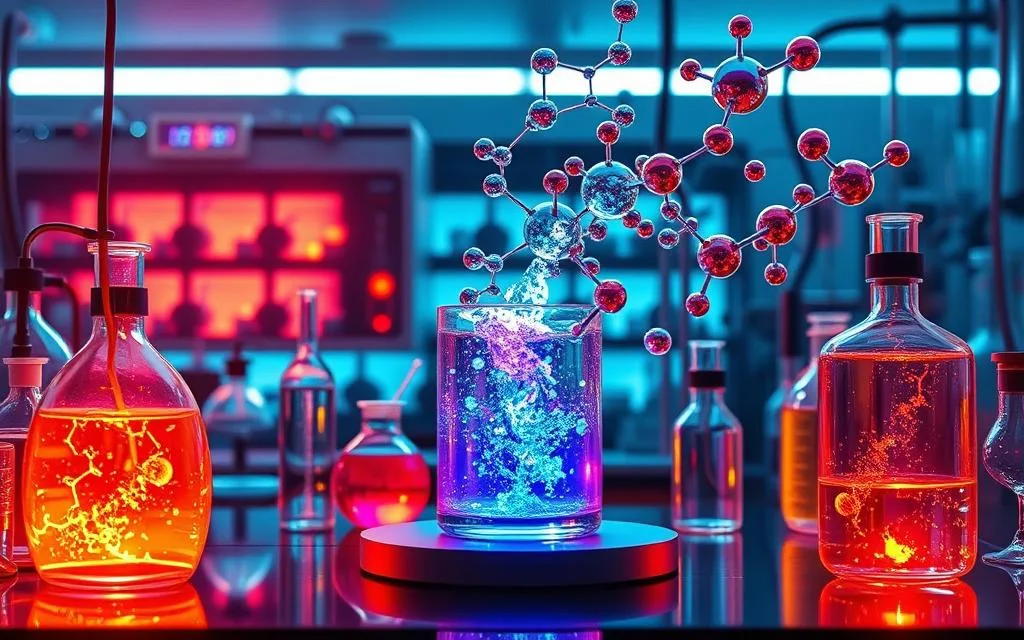Photoelectrochemical asymmetric catalysis is a new way to improve chemical processes. It combines electrochemistry and catalysis to make reactions more efficient and green, which is key for sustainable chemical processes.
This method helps create eco-friendly and cheaper ways to make chemicals, crucial for reducing the chemical industry's environmental harm.
The Fundamentals of Catalytic Processes
Catalytic processes are key in many chemical reactions and vital for research progress. Asymmetric catalysis, in particular, is important for making chiral molecules. These molecules are crucial in making medicines and other products, where electrochemistry plays a role.
Catalysts speed up chemical reactions without being used up. They do this by lowering the energy needed for reactions to start. This makes reactions faster and more efficient. Asymmetric catalysis is used to make chiral molecules.
Basic Principles of Catalysis
Catalysis basics help us understand how these processes work. There are different types of catalysts. Some are dissolved in the reaction, while others are in a different phase.
Role of Electrochemistry in Catalytic Reactions
Electrochemistry is important in catalytic reactions. It can control how fast reactions happen. This helps in making specific products. New technologies and processes have come from using electrochemistry in catalysis.
Introduction to Asymmetric Synthesis
Asymmetric synthesis is a way to make chiral molecules. It's very important in making medicines and other products. New ways to make chiral molecules have been developed thanks to asymmetric catalysis.
The following table summarizes the key aspects of catalytic processes:
| Type of Catalysis | Description |
|---|---|
| Asymmetric Catalysis | Production of chiral molecules |
| Homogeneous Catalysis | Catalysts are dissolved in the reaction mixture |
| Heterogeneous Catalysis | Catalysts are present in different phase |
In conclusion, knowing about catalytic processes is key for research. Asymmetric catalysis, electrochemistry, and other types have led to new product-making methods. This includes chiral molecules and more.
Photoelectrochemical Asymmetric Catalysis: Mechanism and Components
Photoelectrochemical catalysis combines electrochemistry and catalysis to drive reactions. It's a unique way to make complex molecules with high selectivity. Light is used to generate electrons that power the reaction.
To set up this system, you need electrodes, electrolytes, and a light source. Electrodes are conductive materials like metal or carbon. They help electrons flow. The electrolyte is a solution with ions that aids the reaction. The light source creates the electrons needed for the reaction.
This method has many benefits. It can be very efficient and selective. It also works well under mild conditions. This makes it great for many fields, from making medicines to materials science. It can also reduce the environmental impact of chemical reactions by avoiding harsh conditions or toxic substances.
Here are the main parts of a photoelectrochemical asymmetric catalysis system:
- Electrodes: These are used to facilitate the flow of electrons and are typically made of a conductive material.
- Electrolyte: This is a solution that contains ions and helps to facilitate the reaction.
- Light source: This is used to generate the electrons that drive the reaction.
- Catalyst: This is a substance that helps to speed up the reaction and can be used to improve the selectivity and efficiency of the reaction.
Photoelectrochemical asymmetric catalysis is a powerful tool for chemical reactions. It has the potential to change many fields. By understanding how it works, researchers can find new uses for this technology.
| Component | Description |
|---|---|
| Electrodes | Conductive material used to facilitate the flow of electrons |
| Electrolyte | Solution that contains ions and helps to facilitate the reaction |
| Light source | Used to generate the electrons that drive the reaction |
| Catalyst | A substance that helps to speed up the reaction and improve selectivity and efficiency |
Applications and Advantages in Industrial Processes
Photoelectrochemical asymmetric catalysis is changing the game in industrial processes. It's a key player in making sustainable chemical processes. This method is cheaper and better for the environment than old ways of catalysis. It cuts down on waste and energy use.
It's making a big difference in many fields, like pharmaceuticals and fine chemicals. Companies are using it to be greener and still save money. The main perks of this method are:
- Less energy and waste
- Better efficiency and productivity
- It's cheaper than the old methods
- It's good for the planet
As more industries use photoelectrochemical asymmetric catalysis, we're getting closer to big-scale use. With better equipment and fitting it into current processes, see even more benefits. This could lead to a greener and more affordable future for industries.

